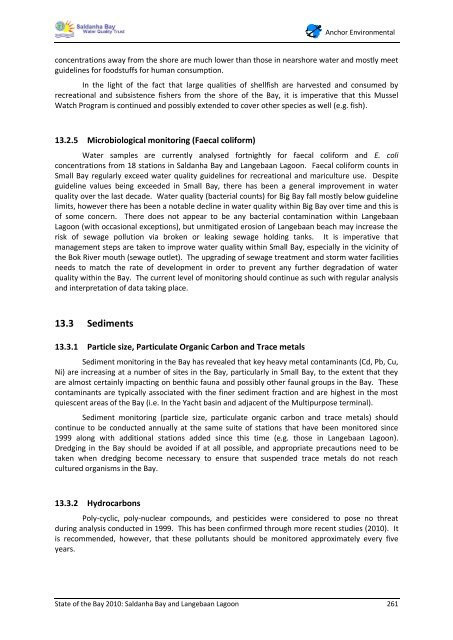State of the Bay Report 2010-Final - Anchor Environmental
State of the Bay Report 2010-Final - Anchor Environmental
State of the Bay Report 2010-Final - Anchor Environmental
You also want an ePaper? Increase the reach of your titles
YUMPU automatically turns print PDFs into web optimized ePapers that Google loves.
<strong>Anchor</strong> <strong>Environmental</strong><br />
concentrations away from <strong>the</strong> shore are much lower than those in nearshore water and mostly meet<br />
guidelines for foodstuffs for human consumption.<br />
In <strong>the</strong> light <strong>of</strong> <strong>the</strong> fact that large qualities <strong>of</strong> shellfish are harvested and consumed by<br />
recreational and subsistence fishers from <strong>the</strong> shore <strong>of</strong> <strong>the</strong> <strong>Bay</strong>, it is imperative that this Mussel<br />
Watch Program is continued and possibly extended to cover o<strong>the</strong>r species as well (e.g. fish).<br />
13.2.5 Microbiological monitoring (Faecal coliform)<br />
Water samples are currently analysed fortnightly for faecal coliform and E. coli<br />
concentrations from 18 stations in Saldanha <strong>Bay</strong> and Langebaan Lagoon. Faecal coliform counts in<br />
Small <strong>Bay</strong> regularly exceed water quality guidelines for recreational and mariculture use. Despite<br />
guideline values being exceeded in Small <strong>Bay</strong>, <strong>the</strong>re has been a general improvement in water<br />
quality over <strong>the</strong> last decade. Water quality (bacterial counts) for Big <strong>Bay</strong> fall mostly below guideline<br />
limits, however <strong>the</strong>re has been a notable decline in water quality within Big <strong>Bay</strong> over time and this is<br />
<strong>of</strong> some concern. There does not appear to be any bacterial contamination within Langebaan<br />
Lagoon (with occasional exceptions), but unmitigated erosion <strong>of</strong> Langebaan beach may increase <strong>the</strong><br />
risk <strong>of</strong> sewage pollution via broken or leaking sewage holding tanks. It is imperative that<br />
management steps are taken to improve water quality within Small <strong>Bay</strong>, especially in <strong>the</strong> vicinity <strong>of</strong><br />
<strong>the</strong> Bok River mouth (sewage outlet). The upgrading <strong>of</strong> sewage treatment and storm water facilities<br />
needs to match <strong>the</strong> rate <strong>of</strong> development in order to prevent any fur<strong>the</strong>r degradation <strong>of</strong> water<br />
quality within <strong>the</strong> <strong>Bay</strong>. The current level <strong>of</strong> monitoring should continue as such with regular analysis<br />
and interpretation <strong>of</strong> data taking place.<br />
13.3 Sediments<br />
13.3.1 Particle size, Particulate Organic Carbon and Trace metals<br />
Sediment monitoring in <strong>the</strong> <strong>Bay</strong> has revealed that key heavy metal contaminants (Cd, Pb, Cu,<br />
Ni) are increasing at a number <strong>of</strong> sites in <strong>the</strong> <strong>Bay</strong>, particularly in Small <strong>Bay</strong>, to <strong>the</strong> extent that <strong>the</strong>y<br />
are almost certainly impacting on benthic fauna and possibly o<strong>the</strong>r faunal groups in <strong>the</strong> <strong>Bay</strong>. These<br />
contaminants are typically associated with <strong>the</strong> finer sediment fraction and are highest in <strong>the</strong> most<br />
quiescent areas <strong>of</strong> <strong>the</strong> <strong>Bay</strong> (i.e. In <strong>the</strong> Yacht basin and adjacent <strong>of</strong> <strong>the</strong> Multipurpose terminal).<br />
Sediment monitoring (particle size, particulate organic carbon and trace metals) should<br />
continue to be conducted annually at <strong>the</strong> same suite <strong>of</strong> stations that have been monitored since<br />
1999 along with additional stations added since this time (e.g. those in Langebaan Lagoon).<br />
Dredging in <strong>the</strong> <strong>Bay</strong> should be avoided if at all possible, and appropriate precautions need to be<br />
taken when dredging become necessary to ensure that suspended trace metals do not reach<br />
cultured organisms in <strong>the</strong> <strong>Bay</strong>.<br />
13.3.2 Hydrocarbons<br />
Poly-cyclic, poly-nuclear compounds, and pesticides were considered to pose no threat<br />
during analysis conducted in 1999. This has been confirmed through more recent studies (<strong>2010</strong>). It<br />
is recommended, however, that <strong>the</strong>se pollutants should be monitored approximately every five<br />
years.<br />
<strong>State</strong> <strong>of</strong> <strong>the</strong> <strong>Bay</strong> <strong>2010</strong>: Saldanha <strong>Bay</strong> and Langebaan Lagoon 261

















